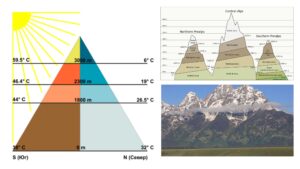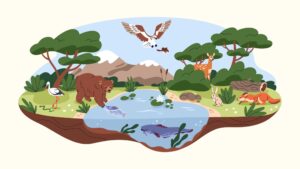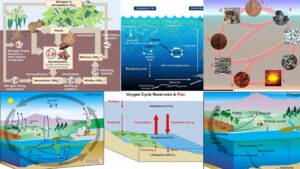Grassland Ecosystem Definition
- Grasslands are areas dominated by grasses. They occupy about 20% of the land on the earth’s surface. Grasslands occur in both tropical and temperate regions where rainfall is not enough to support the growth of trees.
- Grasslands are one of the intermediate stages in ecological succession and cover a part of the land on all the altitudes and latitudes at which climatic and soil conditions do not allow the growth of trees.
- Grasslands make up almost a quarter of the total land surface. The types of plants that grow here greatly depend on what the climate and soil are like.
- Grasslands cover areas where rainfall is usually low and/or the soil depth and quality is poor.
- The low rainfall prevents the growth of numerous trees and shrubs but is sufficient to support the growth of grass cover during the monsoon.
- Grassland ecosystems are influenced over time by the organisms and plants that live there, the local climate, the natural landscape and natural disturbances to the environment such as fires or floods.
- Various species such as buffalo, elephants, badgers, armadillos and many insects have adapted to and are located in grassland environments throughout the world.
- Physical features of grasslands such as wide open grass-covered plains or scattered trees located next to scarce streams help to create a diverse environment within the grassland ecosystem.
Geographical distribution
- During the Cenozoic era, grasslands arose 65.5 million years ago.
- The grassland environment can be found in various places of the world where yearly precipitation is between 70 and 100 centimetres.
- They are found in diverse regions of North America, South America, Australia, Europe, South Africa, and Eurasia, among others.
- Depending on elevation, there are around eight varieties of grasslands in the Western Ghats, the western portion of the Eastern Ghats, and other regions of India.
- But below 600 metres, a variety of grass species have accumulated.
- On the other hand, grassland habitats in the Eastern Ghats receive 25 to 125 cm of precipitation annually.
Different Names of Grasslands
| Other Names of Grasslands | |
|---|---|
| Place | Name of the grassland |
| North America | Prairies |
| Eurasia (Europe and Asia) | Steppes |
| Africa | Savanna |
| South America | Pampas |
| India | Grassland, Savanna |
| Brazil | Campos |
| Venezuela | Llanos |
| South Africa | Veld |
| Australia | Down |
Savannas are a popular term for tropical grasslands. They are found in India, Australia, and eastern Africa. Savannas are grasslands with a smattering of medium-sized trees, and their ecosystem is quite intricate.
Characteristics of the grassland ecosystem:
- Limited yearly precipitation.
- The arid climate all year round.
- Insufficient nutrients in the soil.
- The grasslands are susceptible to drought and variable precipitation.
- Frequent fires due to the semiarid climate and lightning strikes.
- Inferior plant growth dominated by grasses.
- Grasslands support a vast array of animal species.
- It is possible to find grasslands in both tropical and temperate areas if rainfall is insufficient to support tree growth.
- Grasslands are an intermediate stage in biological succession, encompassing a portion of land at all latitudes and altitudes when climate and soil conditions hinder tree growth.
- They occupy around 20% of the earth’s surface.
- The climate and soil conditions have a significant impact on the types of plants that thrive here.
- Grasslands are found in areas with low precipitation and/or poor soil quality and depth.
- Low precipitation hampers the growth of many trees and plants, but monsoon rainfall is sufficient to maintain grass growth.
Components of Grassland Ecosystem
The various structural components of a grassland ecosystem can be categorised as either abiotic or biotic.
A. Biotic Components
- Producers – A few herbaceous plants and shrubs also contribute to the primary production of biomass in grasslands.
- Consumers – In a grassland, there are three basic types of consumers:
- Primary Consumers – The primary consumers are herbivores that consume grasses directly. The principal consumers are herbivores such as grazing mammals (e.g., cows, sheep, deer, rabbit, buffaloes, etc.), insects (e.g., Dysdercus, Coccinella, Leptocorisa, etc.), termites, and millipedes.
- Secondary Consumers – These are carnivores that feed on primary consumers (Herbivores). Carnivores include creatures such as foxes, jackals, snakes, frogs, lizards, and birds that feed on herbivores. These are the secondary grassland ecosystem consumers.
- Tertiary Consumers – Tertiary consumers include hawks and other animals that feed on secondary consumers.
- Decomposers — These include death and decay-causing bacteria, moulds, and fungus (e.g., Mucor, Penicillium, Aspergillus, Rhizopus, etc). These return the minerals to the soil, making them accessible to farmers once more.
B. Abiotic Components
- These include the nutrients found in the soil and the atmosphere.
- Plants require the elements hydrogen, oxygen, nitrogen, phosphorus, and sulphur.
- These are provided by the soil and air as CO2, water, nitrates, phosphates, and sulphates.
- In addition to these, the soil contains a number of trace elements.
1. Soil
- This ecosystem’s soil is exceptionally productive since it includes carbon, nitrogen, oxygen, phosphorus, etc.
- The majority of tropical grassland ecosystems are situated in chernozem soils. However, river valley locations have laterite soils.
- In contrast, the soils of temperate grasslands are rich in organic matter. There are Chernozem and chestnut soils in this temperate region. In addition, the Polar grassland habitat experiences snowfall the majority of the time.
2. Temperature
- The yearly average temperature ranges from -20°c to 30°c in various grassland environments.
- In nature, tropical grassland habitats are both dry and humid. Consequently, they are always heated.
- The grassland is frigid in the winter and warm in the summer. In addition, the polar grassland experiences frigid temperatures throughout the entire year.
3. Rainfall
- The typical annual precipitation of grassland habitats is between 40 and 100 centimetres. Tropical grassland habitats receive the most precipitation.
- The amount of precipitation in the ecology of temperate grasslands is not very high. This environment typically receives precipitation in the summer.
- Very little precipitation falls on the polar grassland environment (less than 25 cm)
4. Topography
- The terrain is an abiotic factor that influences an ecosystem. Topography refers to a region’s elevation. In some locations, the height of the tropical grassland ecosystem is extremely high, while in others, it is extremely low.
- Typically, temperate grassland habitats are found on flat terrain. And ecosystems of polar grasslands are observed at great altitudes.
Flora of Grassland Ecosystem
- Natural or semi-natural ecosystems are grasslands dominated by unsown populations of wild plants (“unimproved grasslands”).
- In the semi-natural grassland, the main trees include Quercus robur, Betula pendula, Corylus avellana, Crataegus, and other species.
- The size of the plants can range from tall to short.
- Tall grasses grow in North America’s tall grass prairies, South America’s grasslands, and Africa’s savanna.
- Some grasslands, such as African savannas and Iberian deheza, may contain woody plants, shrubs, or trees, generating savannas, scrubby grassland, and semi-wooded grassland.
- In regions with annual precipitation ranging from 500 to 900 millimetres, grasses are as abundant as blooming plants and trees.
- Perennial grasses and forbs form intricate mats that stabilise the soil.
Fauna of Grassland Ecosystem
- Grasslands are home to the greatest number of huge animals in the world.
- Some of the animals on the list are the jaguar, the African wild dog, the pronghorn, the black-footed ferret, the plains bison, the mountain plover, the African elephant, the Sunda tiger, the black rhino, the white rhino, the savanna elephant, the bigger one-horned rhino, the Indian elephant, and the swift fox.
- The grasslands of the African savanna are inhabited by grazing animals, herd animals, and predators such as lions and cheetahs.
- Mites, insect larvae, nematodes, and earthworms reside in the deep soil that can extend 6 metres underground in undisturbed grasslands with the world’s richest soils.
- Together with symbiotic fungi, these invertebrates lengthen root systems, break up compacted soil, refill it with urea and other natural fertilisers, trap minerals and water, and stimulate plant development.
- Large mammals include the blue wildebeest, American bison, huge anteater, and Przewalski’s horse.
Types of Grasslands
As climate plays a significant effect in the establishment of grasslands, it is commonly used to classify the world’s grasslands into two main categories: those that occur in temperate regions and those that occur in tropical regions.
1. Semi-arid Zone
- Semi-arid grassland communities consist of expansive, interconnected grasslands flanked by thickets of trees and shrubs.
- Natural perennial grasses are the most prevalent species.
- The terrain encompasses the northern regions of Gujarat, Rajasthan (excluding the Aravalli Mountains), western Uttar Pradesh, Delhi, and Punjab.
2. Dry Sub Humid Zone
- The biodiversity of dry subhumid regions is well adapted to the challenging conditions defined by erratic rainfall patterns that result in droughts and floods and, in many cases, high temperatures.
- Many of the world’s crops, including wheat, barley, and olives, are cultivated in arid and semi-arid climates.
- This region comprises the entirety of peninsular India in India (except Nilgiri).
3. Moist Sub Humid Zone
- The moist subhumid zone defines regions with a climate that lies between semiarid and humid, and where the precipitation allows for the dense growth of tall or short grasses but not woods.
- It consists of the Ganga alluvial plain in northern India, which is a flat, low-lying region with poor drainage.
4. Humid Montane Regions
- Globally distributed grasslands and shrublands, humid montane grasslands are found at high elevations.
- The term “montane” signifies “high altitude” in the biome’s name.
- In the humid montane areas and moist subhumid zones of Assam, Manipur, West Bengal, Uttar Pradesh, Punjab, Himachal Pradesh, and Jammu & Kashmir, shifting cultivation and sheep grazing have transformed humid forests into savanna.
5. Tropical Grasslands
- These are found on both sides of the equator and stretch throughout the tropics.
- This plant grows in locations with moderate to low precipitation.
- The grass can reach heights of approximately 3 to 4 metres.
- Savannah grasslands are found in Africa.
- In tropical grasslands, elephants, zebras, giraffes, deer, and leopards are common.
6. Temperate Grasslands
- The precipitation range for temperate grasslands is between 25 cm and 75 cm. In addition, the environment of the temperate grasslands causes it to be both dormant and active.
- Furthermore, these grasslands endure harsh weather. During the cold season, the temperature can drop below 0 degrees Fahrenheit at Flooded Grasslands.
- In some regions, summer temperatures can reach up to 90 degrees. These grasslands receive the majority of their precipitation in the form of dew and snow.
- For example, cacti, sagebrush, perennial grasses, buffalo grass clovers, and wild indigos flourish here, among other plants.
7. Flooded Grasslands
- The flooded grasslands have water throughout the year. Additionally, these grasslands have a variety of aquatic plants.
- Numerous waterbirds travel to these regions, while others are permanent inhabitants. Notable the Everglades is the greatest flooded grassland in the world.
- In addition, it contains several species of birds, fish, mammals, reptiles, seed-bearing plants, amphibians, and butterflies, among others.
8. Montane Grasslands
- These grasslands are high altitude shrublands, as the term “montane” means “high altitude.” These are considered high altitude since they are located above the tree line.
- In addition, the plants here have a rosette-like form, numerous hairs, and waxy surfaces. The northern Andes, for example, contain this type of ecosystem.
9. Desert Grasslands
- Desert grasslands are the type of grasslands that separate the lowlands’ actual desert from the montane grasslands.
- In addition, these grasslands receive less precipitation. As a result, these grasslands are the warmest and driest.
- These grasslands are largely dispersed since they are dependent on rainfall locations. Because precipitation differs between regions.
- Consequently, the vegetation of the grasslands differs as well. In addition, numerous animal species inhabit these grasslands.
- Reptiles such as the prairie rattlesnake, western diamondback, and gopher snake are present. In addition, Horned larks, Larkbuntings, Meadowlarks, and scaled quail are present.
10. Polar grassland ecosystem
- Alpine or polar grassland ecosystems are found at greater elevations.
- This habitat is always covered in snow.
- Here, snowfalls and blizzards are common. The average temperature of these grassland habitats is below 10 degrees Celsius.
- Low total annual precipitation characterises the polar grassland environment (10 to 40 cm).
- This environment has grasses, algae, moss, lichen, etc. of various sorts. Nonetheless, numerous annuals grow in the summer.
Food Chain of Grassland Ecosystem
Grassland environment is an open, grass-covered area that provides home for a variety of plant and animal species. All of these species are essential to the grassland ecosystem’s food web.
Producers, main consumers, secondary consumers, scavengers, and decomposers make up the grassland food chain. Along the food chain, energy moves from one species to another. The food chain helps to maintain the ecological balance of all organisms.
Producers
- Producers form the foundation of an ecosystem’s food chain, and the grassland ecosystem is no exception. Indirectly or directly, the producers are the principal source of energy for all grassland organisms.
- The category of producers includes vegetation. They produce food, i.e., energy, through the photosynthesis process for themselves and other species that rely on them for food.
- Producing plants in the grassland habitat include star grass, acacia trees, jackalberry trees, lemongrass, and red oat grass, among others.
Primary Consumers
- Primary consumers are those animals that eat producers to satisfy their food and energy requirements. Primary consumers include animals including antelopes, gnus, giraffes, zebras, gazelles, and elephants, among others.
- The grassland Ecosystem’s principal consumers make up the second tier of the food chain.
Secondary consumers
- The carnivorous and omnivorous animal species are regarded as secondary consumers of the grassland ecosystem. These creatures obtain their energy from primary consumers.
- Carnivores are the secondary consumers of the grassland ecosystem, consisting primarily of big cats, whereas omnivores include hyenas, wild dogs, snakes, etc.
Scavengers
- Scavengers are animals that consume the dead remnants of other species. For example- hyenas, jackals, vultures, etc. These animals are a tier above secondary consumers.
- Scavengers perform a vital function in the ecology by reducing the amount of dead animal waste and reintroducing nutrients from dead leftovers.
Decomposers
- Decomposers, which include fungi, bacteria, termites, and so on, are at the top of the food chain in a grassland environment.
- Decomposers are organisms that feed on decaying plant and animal debris, releasing inorganic nutrients like carbon dioxide back into the environment.
- Additionally, decomposers contribute to nutrient cycling by breaking down organic matter.
Grasslands in India
- India’s grasslands come in a variety of forms, including small-scale village grazing grounds (Gauchar), large-scale low pastures in the country’s arid western areas, and the high alpine meadows of the Himalayas.
- Annual and perennial grasses predominate here.
- Himalayan pastures are found at great altitudes in the highlands of the Himalayas.
- South of the Himalayan foothills, in the low-lying Terai belt, you can find areas with dense elephant grass.
- Grasslands in India’s semiarid interior can be found in the Deccan Plateau, Central India, and the western section of the country.
- In South India, you can find shola meadows in small areas on the slopes of the hills, right next to the incredibly wet evergreen woods.
- Other types of herbaceous plants such as sedges, legumes, and sunflower relatives can thrive in grasslands.
- Numerous herbivores, ranging in size from insects to huge mammals, find sustenance on grasslands.
- Grassland mammal species range from rats and mice to elephants and canines to buffalo and tigers and lions and even ferrets.
- One horned rhinoceros are among the grassland animals of northeast India that are in danger of extinction.
- Birds in great numbers give the grassland its vibrant hues.
Grassland Animals
- Grasslands play a crucial role in the food chain by providing feed for livestock that are slaughtered for meat and dairy products.
- North American grasslands are home to prairie dogs and mule deer, whereas Africa is teeming with giraffes, zebras, and lions.
- Mammals that graze, birds that nest on the ground, insects, and even some reptiles call this place home.
- Animals like bears, deer, rabbits, and beavers can be found on the grasslands of the temperate zones. The cheetah, zebra, and giraffe all call the grasslands of the tropics home.
Grassland Plants
- Some of the most common flora are buffalo grass, sunflowers, crazy weed, asters, blazing stars, clover, and wild indigo.
- Several types of grasses can be found here as well. Grass species such as purple needles grass, wild oats, fox tails, ryegrass, and buffalo grass do particularly well in this ecosystem.
- The trees are modest and few. there are largely shrubs. The wind often carries the seeds of various grassland plants.
Functions of Grassland Ecosystem
They’re used for specific purposes. This includes:
- The transmission of vitality up the food chain
- Substitutes for nutrients (biogeochemical cycles)
- Ecological development or succession
- Mechanisms of homeostasis, cybernetics, or feedback control
- To control ecosystem productivity and boost soil fertility.
- In order to mitigate mineral loss caused by insufficient precipitation.
Economic Importance of Grasslands
- Many rural areas rely on grasslands as grazing land for livestock.
- Livestock farmers like cow and goat herders and sheep and goat shepherds rely heavily on grasslands.
- The village’s ‘common’ area is used for grazing domestic animals.
- When summer grass dries up, cattle are fed stored fodder until the next spring.
- Thatching homes and barns is another common application for the grass.
- For the most part, people in grasslands use the thorny bushes and branches of the few trees they can find as a source of fuelwood.
- Many grasslands have been degraded because of overgrazing by large herds of domestic cattle.
- Pollinating insects can be seen in large numbers in grasslands.
- Small animals like shrews, lizards, birds of prey, frogs, and toads are only few of the predators that hunt on these insects.
- Insect infestations in neighbouring farmland can be reduced thanks to the predation of these carnivores.
Facts about the grassland ecosystem
- Grass species such as tor grass, blue moor-grass, false oat grass, rough meadow grass, cocksfoot, etc. dominate this habitat.
- There are no large trees in this ecosystem, hence it is classified as a transitional zone because grass is the primary producer here. In a few spots, you can even spot a few little trees.
- Grasslands are characterised by a dry environment and poor soil quality. There isn’t enough nutrients in the soil for big plants to thrive here. This allows for the growth of grasses and tiny trees.
- In a grassland environment, you’ll find a plethora of fast-growing tree species.
- Temperatures are higher in their natural grassland environments.
- Temperatures in grassland ecosystems often fall between 15 and 35 degrees Celsius.
- In this habitat, the dry season may extend for as long as eight months.
- Rainfall in this ecosystem averages between 50 and 100 centimetres per year. Therefore, grasses flourish in this environment.
- Grass species in this area exhibit seasonal variation in their outward appearance. The grass is as harsh and lifeless as it is in the dead of winter. The grasses in this habitat go from a drab brown to a vibrant green during the wetter months.
References
- Sala, O. E., Vivanco, L., & Flombaum, P. (2013). Grassland Ecosystems. Encyclopedia of Biodiversity, 1–7. doi:10.1016/b978-0-12-384719-5.00259-8
- Bengtsson, J., Bullock, J. M., Egoh, B., Everson, C., Everson, T., O’Connor, T., … Lindborg, R. (2019). Grasslands-more important for ecosystem services than you might think. Ecosphere, 10(2), e02582. doi:10.1002/ecs2.2582
- Blair, John & Nippert, Jesse & Briggs, John. (2014). Grassland Ecology. Ecology and the Environment. 389-423. 10.1007/978-1-4614-7501-9_14.
- https://www.brainkart.com/article/Structure-and-functions-of-Grassland-Ecosystems_7436/
- https://sciencequery.com/grassland-ecosystem-types-biotic-and-abiotic-factors/
- https://www.vedantu.com/biology/grassland
- https://www.pharmaguideline.com/2022/01/forest-ecosystem.html
- https://www.earthreminder.com/grassland-ecosystem-types-characteristics/
- https://www.toppr.com/guides/science/nature/ecosystem/types-of-grassland-ecosystems/
- https://prepp.in/news/e-492-grassland-ecosystem-environment-notes
- https://storymaps.arcgis.com/stories/dcfa84e0be994029b20ad20c27fde94a
- https://kids.nationalgeographic.com/nature/habitats/article/grassland
- https://www.k-state.edu/ecophyslab/pdf’s/Grassland%20Ecology_Springer_Reference_series.pdf
- https://sciencing.com/what-is-a-grasslands-ecosystem-13404944.html
- https://www.jagranjosh.com/general-knowledge/grassland-ecosystem-components-structure-and-economic-importance-1556176113-1
- https://en.wikipedia.org/wiki/Grassland
- https://www.geeksforgeeks.org/grasslands-definition-types-functions-importance/
- https://esajournals.onlinelibrary.wiley.com/doi/10.1002/ecs2.2582
- https://education.nationalgeographic.org/resource/grassland-biome
- https://prepp.in/news/e-492-grassland-ecosystem-environment-notes



